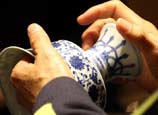
GENEVA, April 3 (Xinhua) -- The Alpha Magnetic Spectrometer (AMS) team led by Nobel laureate Samuel Ting announced on Wednesday the first results in the search for dark matter, reporting an excess of positrons in the cosmic ray flux.
Ting's team found out that the positron fraction increases from 10 GeV to 250 GeV, with the data showing the slope of the increase reducing by an order of magnitude over the range 20-250 GeV. The data also show no significant variation over time, or any preferred incoming direction.
These results are consistent with the positrons originating from the annihilation of dark matter particles in space, but not yet sufficiently conclusive to rule out other explanations.
"Over the coming months, AMS will be able to tell us conclusively whether these positrons are a signal for dark matter, or whether they have some other origin," said AMS spokesperson Ting.
The AMS results, to be published in the journal Physical Review Letters, were based on some 25 billion recorded events, including 400,000 positrons with energies between 0.5 GeV and 350 GeV, recorded over 18 months, according to Ting.
This represented the largest collection of antimatter particles recorded in space.
Cosmic rays are charged high-energy particles that permeate space. The AMS experiment, installed on the International Space Station, is designed to study them before they have a chance to interact with the Earth's atmosphere.
An excess of antimatter within the cosmic ray flux was first observed around two decades ago. One possibility for the origin of the excess, predicted by a theory known as supersymmetry, is that positrons could be produced when two particles of dark matter collide and annihilate.
However, the AMS measurement cannot yet rule out the alternative explanation that the positrons originate from pulsars distributed around the galactic plane. Supersymmetry theories also predict a cut-off at higher energies above the mass range of dark matter particles, and this has not yet been observed.
"AMS is the first experiment to measure to one percent accuracy in space. It is this level of precision that will allow us to tell whether our current positron observation has a dark matter or pulsar origin," Ting said.
Dark matter is one of the most important mysteries of physics. Accounting for over a quarter of the universe's mass-energy balance, it can be observed indirectly through its interaction with visible matter but has yet to be directly detected.
Launched on May 16, 2011 by the shuttle Endeavor in its last mission, the AMS-2 started to send data back to the earth on May 19. The first results were based on data collected from May 2011 to Dec. 2012, he said.


















 1,000-meter-long Spider Walk of Canton Tower opens
1,000-meter-long Spider Walk of Canton Tower opens


![]()
